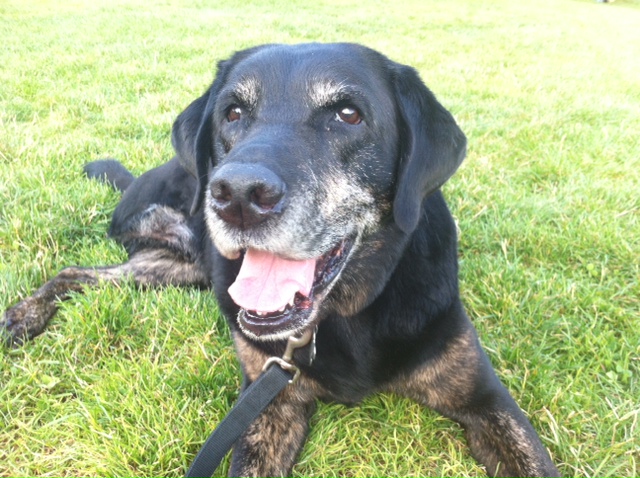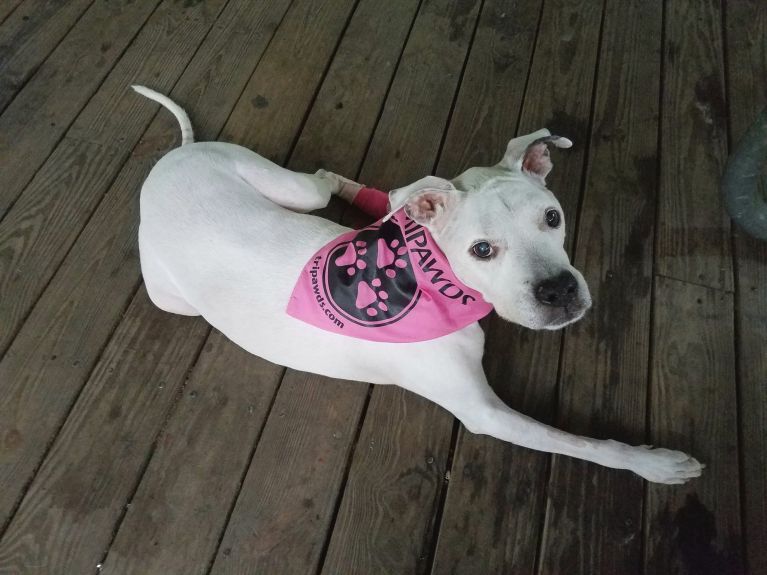The very idea of a remaining leg surgery for Tripawd dogs is terrifying. Cruciate repairs, total hip replacement and other orthopedic surgery recoveries can do wonders, but recovery is tough. So today we are checking in with a vet expert to find out how we can prevent these surgeries in the first place.

Our Tripawds orthopedic expert is Dr. Denis Marcelin-Little, professor of Surgical and Radiological Sciences at the University of California at Davis and one of the world’s best vet experts on orthopedic surgery and recovery.
Here’s How to Avoid a Leg Surgery for Tripawd Dogs
The choices we make while our Tripawd dog is young and healthy pay off later in life. Watch below to find out how Dr. Marcelin-Little says we can help our amputee avoid orthopedic procedures caused by joint stress, obesity and the wrong kind of exercise. You’ll learn important tips like:
- Small proactive decisions you make now will pay off. Manage a Tripawd’s osteoarthritis risk factors, environment and the type, amount, intensity and frequency of activity to prevent surgery later.
- Keeping fit is critical. A Tripawd who is fit and well-managed is better protected from injuries.
- Why Frisbee and ball throwing is a bad idea. These are the most intense, risky activities for a Tripawd.
- A total hip replacement or cruciate tear repair in a three-legged dog is not impossible. But, this procedure is risky on amputee dogs and is best left to experienced surgeons with good rehab therapy teams.
- Successful orthopedic surgeries on a Tripawd’s remaining leg greatly improves quality of life.
Today’s abridged chat with Dr. Marcellin-Little features the final episode of our four-part on-site interview series with faculty members at UC Davis School of Veterinary Medicine from October 2019. Catch all unabridged interviews on Tripawd Talk Radio.
Below the video, you can read our unabridged transcript with Dr. Marcellin-Little to learn even more about how to help your Tripawd avoid another leg surgery and stay strong for life.
Listen below for our entire interview with Dr. Marcellin-Little on Tripawd Talk Radio. Or, keep reading for the full transcript of today’s interview only.
Be sure to catch Part I of our interview with Dr. Marcellin-Little,
“Osteoarthritis Problems in Three Legged Dogs”

Transcript: How to Avoid a
Remaining Leg Surgery for Tripawd Dogs
with Dr. Denis Marcellin-Little
TRIPAWDS: What is it like to do a joint replacement on a three-legged dog?
MARCELLIN-LITTLE: Joint replacement in three-legged dog is easy. It’s the recovery that’s difficult. And then there are things we should be doing slightly differently in surgery because they are three-legged. A dog that’s missing a back leg is going to do two things. It’s going to have a pelvis that tilts kind of toward the missing leg and it’s going to have the tendency to move the remaining leg towards the middle of their body. They do two things that actually don’t offset each other but rather, make the risk of having a luxation (https://www.acvs.org/small-animal/patellar-luxations) after a total hip increase greatly. Both tilting the pelvis and shifting the leg increase the chance of having a certain form of luxation in the legs.
We do this surgery a little bit differently. It would be very helpful to scientifically evaluate a bit more specifically what happens to the pelvis of a dog that’s missing a pelvic limb. We have a bit of an idea and I collaborated with a small group to gather initial information about that in dogs with – that needed TPLOs but we don’t know as much as we should. We can again do surgeries slightly differently and then the recovery is critical. The first few weeks, learning to walk, walking safely and beyond. There are strategies during recovery.
I’ve written a little bit about this in a chapter in Veterinary Clinics of North America, about (dogs) recovering from total joint replacement. My most recent patient has recovered safely – my three-legged patient who got a total hip. It’s a little bit more scary and overall, the literature suggests that there is a higher risk but there are strategies that can be used to make that safer. It’s a risk but it’s also a benefit. Joint replacement in dogs with a lot of hip pain who only had one back leg may become barely able to walk. If a total hip is done successfully, it will greatly improve their quality of life.
Safe surgery recoveries begin with healthy, fit and protected Tripawds.
TRIPAWDS: What about a hip replacement surgery in an older Tripawd dog?
MARCELLIN-LITTLE: You could imagine that any dog that has difficult mobility has challenges in mobility for a reason. That can make their recovery from total hip a little bit difficult or scary or risky. We have to analyze why the dog has difficulties. Comorbidities as they are called in people. And again, there is not great scientific literature about comorbidities in orthopedics. We know they increase the complication rate.
In the absence of clear literature, we’ve got to just evaluate each dog. Why do they have difficulty with their mobility? What can we do differently during the recovery? Their challenges are going to put a total hip (replacement) at risk. These things can be managed but you have to be very mindful.
We do a much better job managing challenges when we think about them before a catastrophic event. To say, well, this dog – maybe we can improve his mobility a little bit before surgery. Maybe we have to pay special attention to the support that we provide after surgery, or the surfaces that the dogs walk on, the environment where the dog sleeps or rests or goes outside. By being a little worried about all these things ahead of time, we are going to make surgeries safer.
TRIPAWDS: How do we help our Tripawd avoid getting a joint replacement surgery in the first place?
MARCELLIN-LITTLE: First, we would not be able to avoid all situations. Some accidents and some injuries are going to happen even with the best intentions. And so sometimes a dog will have a cruciate ligament injury coming out of the blue. They seem to be showing up even in dogs who are very peaceful and well-behaved and well-managed.
Watch Murphy, six months after a total hip replacement
Our Tripawd’s weight and fitness has a profound impact on life.
But clearly, it’s up to us to be responsible for our dog’s fitness and fatness because we have the power as dog owners to control what they do. And everybody will agree that a dog that’s a little bit more slender and a little bit more fit will have an easier time. Particularly if they have only three legs. Sometimes I tell people, being a little fat dog is kind of cute and well-accepted and common but now that your dog only has three legs, we no longer should do that.
Now, every pound is really the enemy. Before, it was something to kind of chat and discuss and argue to have their dog on the lean side. But now, it’s really on your to-do list. It’s going to have a profound impact in the present. We know dogs who are losing weight walk better. It’s pretty obvious. It’s basic physics.
But we also know that any kind of predisposing problems such as osteoarthritis that the dog has will progress much more rapidly if the dog weighs more. We can’t really afford to accelerate osteoarthritis in a dog that only had three legs where each leg now is absolutely critical. Each joint is critical because there is that loss of redundancy by losing a leg.
So fitness, lean body conditions are very critical, and becoming more fit. There’s a lot of misconception among owners about exercise. They tend to think all exercises are equally beneficial and tend to be equally intense. They don’t always put a lot of thinking into the nature of the exercise, how exercising dogs really can vary greatly in the risk and intensity that it carries.

The right exercise for Tripawds is critical.
So often, people only think of exercise as catching a Frisbee or retrieving a ball. By human terms, that would be extremely violent exercise and they are not exercise that most people will do for themselves. But they tend to think of dogs for some reason very differently than they think of themselves. There is a lot of room in our society to educate people about exercise, about the need for precision and thinking in the amount, the intensity, the frequency of exercise.
It’s the same thing for fitness. We don’t pay that much attention to the fitness of our dogs, their core strength. Particularly important in amputee is their limb strength. Invest into your dog by having a dog that is fit and that is lean. The dog is protected against injury. I could say the same thing for four-legged dogs. It becomes particularly critical for three-legged dogs.
Exercise can be scientifically established and optimized. Body condition can be also optimized. All these things are reversible but they need – there are problems that cannot be solved on the spot. So that’s the special challenge for us human beings. We love to solve problems immediately and permanently. And those are problems that require many good decisions along the way. And so they are much more difficult to achieve success with fitness, with training, with exercise because they require a lot of energy and support from the caregiver. That’s something that we can do.
Small decisions now pay off later.
I spend time educating people about how to be successful or how to talk to clients. I educate veterinarians when I discuss managing osteoarthritis, always paying attention to how challenging it is to achieve fitness and to have lean dogs that it’s not going to be successful by just telling the owner that their dog is fat and unfit. That it will require sustained communications and unfolding a map for the owner to say, “This is how we are going to get there.” And so on. And so, it’s in everybody’s best interest to be really interested in their dog’s fitness and socialization and training and exercise habits. And we are not doing a great job as a country or as a species working with our dogs that way.
Small decisions along the way with regards to activity and a way to make life a lot easier down the road regardless of the situation. So a small effort today will bear fruit over time.
[End of second video transcript,
Remaining Leg Surgery for Tripawd Dogs]
Our Shiba Inu lost his back leg about five years ago. He loves to run and has now torn his meniscus on his remaining back leg. The vet has given us two options for surgery
TPLO: Tibial Plateau Leveling Osteotomy (TPLO) is a surgical treatment used to stabilize the stifle joint when the Cranial Cruciate Ligament with a metal plate
OR
TTA: tibial tuberosity advancement (TTA), extracapsular repair, and the Tightrope® method
Does anyone have any experience with this and have a more concrete option that they saw lasting results with? We are really struggling with the possibility of him getting an infection, the bone not healing, or the metal plate shattering vs the rope not being effective and him needing surgery every couple years. We are desperate for any sort of information on this and really appreciate any advice.
Hi Katie,
I’m sorry about your pup. We have more information in our Remaining Leg Surgery articles. I also encourage you to post in our Hopping Around Discussion Forum so that you can get feedback from others about the tightrope method, there’s information in the forums from our resident vet expert. See you there!
Can you tell me more on the success rate on leg surgery on the remaining back leg. I have a 6 year old springer, lean, fit lost his back leg through crutiate damage at the age of two. Has just started to show signs of discomfort, in the evening after sleeping seems to struggle to get up on his leg. Has cried a few times when rolling over or stretching out on the floor. Not sure if hip or leg.. After a short time and some Tia gentle massage comes fine again..
Natalie, all situations are different, it really depends on so many factors like the surgeon, the rehab team, the dog’s health, etc. Unfortunately there are no hard numbers on success rates for Tripawds other than this study we participated in.. Your best bet is to start with a canine rehabilitation therapist evaluation. The Tripawds Foundation can even pay for your first visit. Please keep us posted here in the Forums where you’ll find much more support.